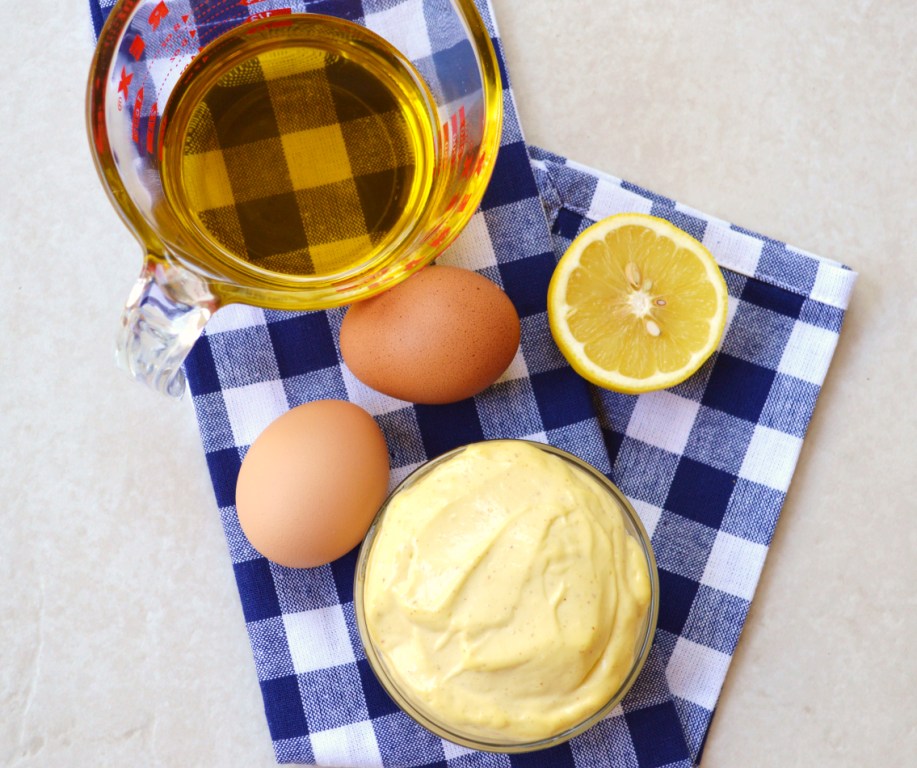Copyrighted 2013 by Jacqueline Peppard. All rights reserved.
The olive oil mayonnaise recipe offered below is a creamy light yellow, and it bears little resemblance to the familiar grocery store versions manufactured with heat, hexane, distilled vinegar, and additives. In addition to tasting great on just about anything, it is also a base for creating other salad dressings.
If you are accustomed to Miracle Whip or even the organic versions made with soybean, cottonseed, or canola oil, this might take a little getting used to. However, any vacillation in resolve is easily eliminated by reading the labels on grocery store varieties.
Don’t you believe it when others say it is okay or even healthy to use the cheaper virgin varieties of olive oil in your mayo. Pass the hexane please!
All olive oils not labeled “cold pressed” are extracted using heat which degrades the nutritional quality of the oil. There is no regulation within the industry to date to limit unscrupulous manufacturers from labeling virgin oil as extra-virgin oil. Moreover, the olive oils labeled as light, pure, or as just olive oil used the chemical solvent, hexane in conjunction with heat to remove the oil from the olive, nut, seed, or grain. No thank you, not in my food.
If you don’t believe me, check out what the Olive Oil Times has to say about current olive oil production.
By reading the labels on commercial mayonnaise, you will soon realize they are predominately made out of soybean and or cottonseed oil. Both of these oils are products of the industrial age hexane extraction process, and they are toxic for your body. The ones touting olive oil on their label contain relatively little of it.
The French and Spanish were first, or so they say.
Traditionally made cold-pressed extra-virgin (first press) olive oil was the main ingredient used by the Spanish and French in the 18th century, both of which, claim to be the original creators of mayonnaise. It is believed they combined oil, vinegar, and aspic (jellied meat broth used as the emulsifier) in the 18th century. Later in the early 19th century, raw egg appeared as the emulsifier and lemon was used instead of or along with the vinegar. Like the recipe below, the mayonnaise was chilled (”put to ice”) before using.
Omega 6 to Omega 3 ratios, what’s that?
According to Loren Cordain, author of the Paleo Diet, the hunter gatherer diet consisted of Omega 6 to 3 fat ratios between 2:1 or 1:1.
Excepting macadamia oil, cold pressed extra-virgin olive oil has the best balance of omega-6 to omega-3 fat out of all the healthy to consume affordable oils, but a ratio of 13.1:1, which still isn’t great, beats the heck out of cottonseed oil which contains a ratio of 258:1.So much for obtaining omega 3 from olive oil because you aren’t. Macadamia oil has a much better ratio, but then the mayo is going to taste, well, like macadamias.
Olive oil’s saving grace, phew…
Olive oil is high in cholesterol lowering monounsaturated fatty acids and low in those nasty PUFA’s (polyunsaturated fatty acids). It’s consumption dates back thousands of years, at least 6,000 and probably earlier, so our ancestors have thoroughly road tested this oil for us.
Forget about canola oil and its supposed benefits. Recent studies suggest canola oil may produce heart scarring and liver damage.The rape seed strain used to manufacture canola oil is a product of modern science and didn’t exist prior to 1970. If you would like to read more about the different oils and their profiles, Loren Cordain offers an in depth discussion on his website.
To prevent rancidity, skip buying large tins of oil. Purchase oil in smaller quantities and packaged in opaque glass or tin containers to preserve the beneficial properties of the oil.
Okay, finally the recipe:
Mayonnaise – Blender or Food Processor Version
Yield: 1 1/4 cups
Combine in a blender or food processor:
1 large egg
1/2 TSP dry mustard or 1 TSP wet
1/8 TSP sweet paprika
1/4 TSP salt
1 TBS cane sugar or 1/2 TBS honey
Whiz on high until thoroughly mixed.
While processor or blender is running (with lid on) slowly drizzle through feeder hole or tube:
1/2 cup olive oil until thoroughly blended; then
3 TBS lemon juice until thoroughly blended; then
1/2 cup olive oil more and blend until thick.
Stop as necessary to scrape down all the ingredients from sides of container and to blend in. With the last 1/2 cup oil, you will start to see small waves beginning to form. Also, it will start to sound different as it thickens. Magic!
Store refrigerated in a glass container or canning jar. The mayonnaise will become thicker once it cools, and it will last up to two weeks.
Variations:
For a thicker consistency, use two egg yolks in place of the 1 whole egg. However, now you are confronted with the age old question of what to do with the left over egg whites.
May be made completely with vinegar.
For initial forays into the world of gourmet mayonnaise, embellish with fresh herbs like basil, dill, tarragon, or thyme (about two tablespoons) cut and gently folded in after you have made the mayo.
2-4 peeled and pressed garlic cloves added to first step for Aioli sauce.
Lemon zest, about 1 TSP folded in at the end.
Pinch of white pepper.
Cooks Notes: While many recipes will insist the eggs, oil, lemon juice, and bowl must be room temperature, I have never worried about it when using a blender or processor. The machines will heat up the ingredients a bit, so I find it better to start cold. The room temperature rule (this assumes you dwell in a 70 degree house) has more to do with whisking it by hand. The olive oil used in the mayonnaise will solidify as it chills, so don’t fret if the final product looks a tad thin initially.

